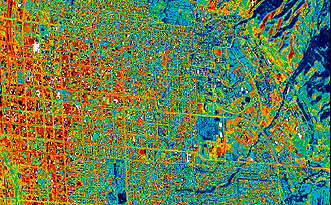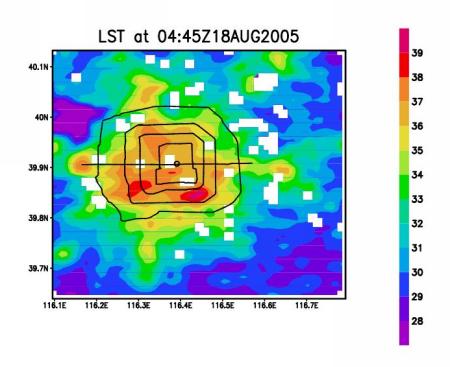In the next few months, I will be writing about climate and climate change. My purpose is to discuss the various ways we influence climate both locally and globally. The plan is to start locally, with the effect of cities on climate. I will follow with a discussion of our effects on regional climate, and then close with a look at the global climate. This sequence will probably be interrupted by other topics if they come up.
1. Local climate
Local climate is probably the easiest for us to understand because we can see it in our daily lives. It has been known for decades that cities affect climate. Before air conditioning, the cities would get so hot in the summertime that people who had the money would leave the cities during the weekends for cooler weather in the countryside.
The figures show two examples. In Figure 1, an infrared image of Salt Lake City, notice how the urban area (yellow and red) is warmer than the suburbs (mixed greens and blues) which are warmer than the surrounding mountains. I’m not sure why some of the mountains (upper right) look warm – perhaps there are rocks there. Figure 2 is a satellite image from MODIS (MODerate Resolution Imaging Spectroradiometer) showing the surface temperatures in Beijing in the afternoon. The MODIS pixels are much larger, so the picture looks blurrier, but the message is the same: Bejing is also warmer than the surrounding area.



good morning
i’am a Globe teacher in cameroon
i want to have more information about global climate change in africa equatorial
I have been trying to find out some information on climate change in Cameroon.
The biggest effect on Cameroon mentioned is that sea level rise would lead to more coastal erosion, which could impact cities on the coast.
I am guessing the temperature effects aren’t very large so far, since most of the temperature impact of global climate change is in the high latitudes.
I don’t know about precipitation, but will continue to check.
Have you noticed any changes over the last several years?
I have read more now — and have discovered that one of the reasons that there is no news about climate change in Cameroon is that it hasn’t been detected yet.
Climate change, over geologic times, seems to be greater near the Poles — and this has to do with the disappearance and reappearance of ice. Ice reflects the sunlight, so icy times get colder for lack of sun to heat the ground. When the ice melts, the opposite happens — more sunlight is absorbed.
Even in the United States, the effect of snow is seen with larger warming in the spring and fall.
Pingback: Climate Change - Overview - GLOBE.gov
If you can show me more information about climate of global i would be very grateful to you.I need to add some information for my homework.I’ll be back to get some useful information.Tks u!